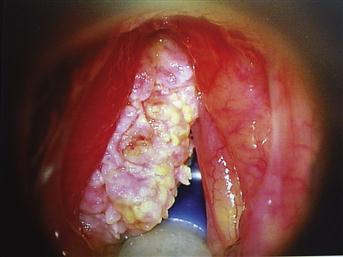Voice Disorders
Voice disorders can be caused by a number of conditions. Change in the quality of the voice ranges from mild hoarseness to aphonia. It is extremely important to exclude laryngeal carcinoma, which is easily treated in the early stages but has a poor prognosis once metastatic spread has occurred.
History
Onset
The temporal profile of deterioration in quality of the voice is useful in discriminating between the causes. Infection and excessive vocal use may result in transient deterioration. Progressive deterioration may be due to tumours, and sustained hoarseness due to recurrent laryngeal nerve palsy.
Precipitating factors
Viral infections usually precede and cause acute laryngitis. It is most commonly due to the influenza virus. Smoking and vocal cord trauma from excessive use by singers, or simply excessive shouting, are often enough to precipitate hoarseness. A history of blunt trauma to the larynx may be evident and hoarseness from resulting laryngeal fractures may be the first indication of a precarious airway.
Past medical history
Recurrent laryngeal nerve palsy associated with a goitre is usually due to thyroid malignancy. Tumour infiltration of the recurrent nerve may also result from malignancy occurring in oesophagus and lung. Hoarseness of the voice may be the first complaint of patients with a thoracic aneurysm. Previous thyroid or thoracic surgery may have resulted in vagus or recurrent laryngeal nerve injuries.
Associated symptoms
Sore throat from pharyngitis may accompany acute laryngitis. Pain referred to the ear or dysphagia can be late presenting features of laryngeal carcinomas. Rapidly progressive dysphagia is also a symptom of oesophageal carcinoma. Nasal voice may be accompanied by ptosis, diplopia and muscle fatigue with myasthenia gravis. Bizarre associated symptoms with impaired voice intensity but normal coughing ability should lead to the consideration of a functional cause; however, this should be a diagnosis of exclusion.
Examination
Indirect laryngoscopy is performed with a mirror and headlamp. If unsuccessful, the larynx can easily be examined with a flexible fibreoptic laryngoscope under local anaesthetic. A dry erythematous larynx is seen with acute laryngitis. Vocal cord papillomas and supraglottic carcinomas may be readily visible. Recurrent laryngeal nerve injury will result in paralysis of the unilateral vocal cord. Upon observing this, a detailed examination is undertaken to determine the underlying cause. The neck should be examined for the presence of a goitre. Palpable supraclavicular lymphadenopathy may arise from oesophageal carcinoma. The chest is carefully examined for signs of collapse and effusion, which may be secondary to bronchial carcinoma.





